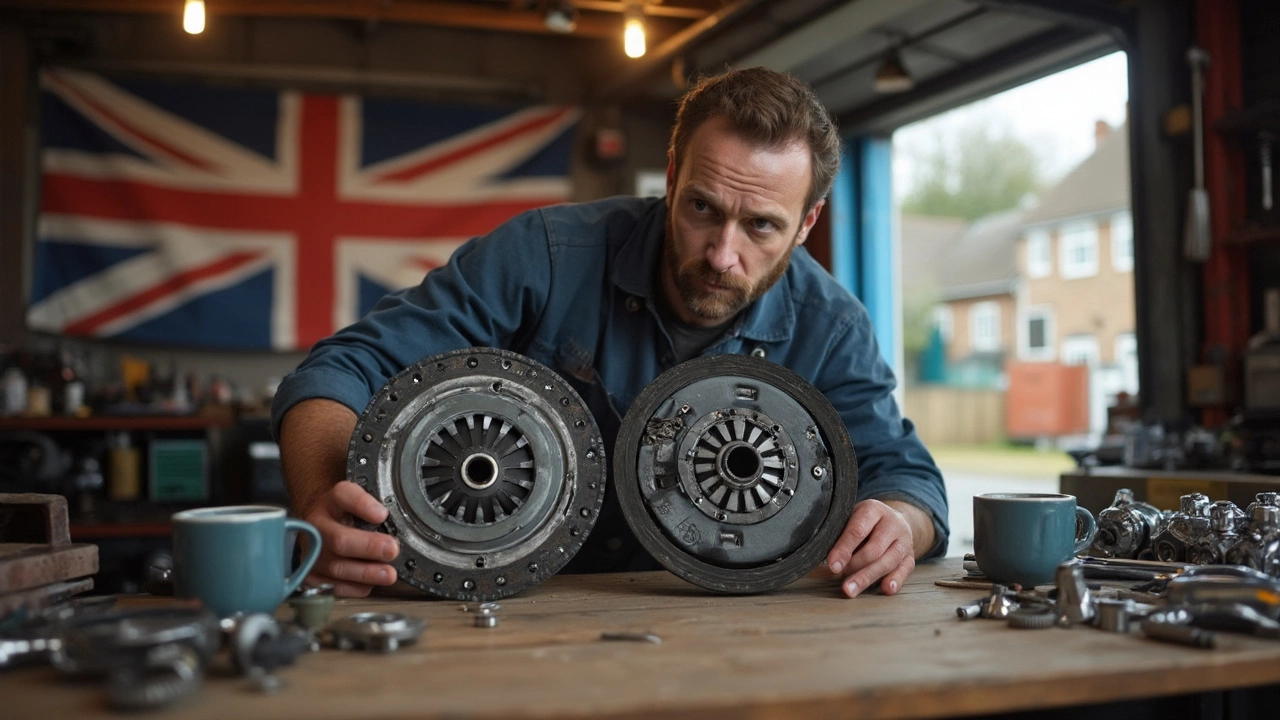Ever seen “stage 1 clutch” listed on car parts sites and wondered if it’s just hype? You’re not alone. The truth is, upgrading to a stage 1 clutch isn’t about showing off at car meets—it’s actually about getting a bit more out of your manual transmission without going overboard.
A stage 1 clutch kit replaces the factory stuff with parts that can handle more torque and more abuse. But here’s the kicker—it’s not just for racers. Daily drivers who’ve bumped up their horsepower a little (maybe you’ve got a tune or a few bolt-ons) use stage 1 clutches to make sure their car keeps up with their upgrades.
If you drive mostly on the street and don’t plan to drag race every weekend, a stage 1 clutch might be your best bet. It gives you a firmer pedal feel and better grip, so you’re less likely to get that dreaded clutch slip when you floor it for a highway merge. And you won’t need Atlas-level leg strength either—the pedal is still comfortable for traffic jams and city driving.
- Stage 1 Clutch: Not Just a Buzzword
- How It Compares to Stock and Other Stages
- Benefits and Drawbacks You’ll Notice
- Who Actually Needs a Stage 1 Clutch?
- Everyday Tips Before and After the Upgrade
- Myths, Mistakes, and Final Thoughts
Stage 1 Clutch: Not Just a Buzzword
Let’s clear up what a stage 1 clutch actually is. You’ll see the term thrown around on forums and parts listings, but it isn’t just marketing jargon. A stage 1 clutch is basically the first step up from the standard, factory clutch that comes in your car. It’s made for folks who want a bit more bite and durability, but don’t need full-on race parts.
Most stage 1 clutch kits swap out basic organic materials for higher quality stuff, like reinforced organic or Kevlar blends. They also tend to use stronger springs and have slightly different friction surfaces compared to stock. This makes them grip better and last longer, especially if your car’s making a bit more power than it did off the showroom floor.
Wondering what’s actually in the box? Most stage 1 kits come with:
- A pressure plate that can handle higher clamp loads
- A clutch disc with improved materials
- A release (throwout) bearing
- Sometimes, an alignment tool so installation goes smoother
Now, why bother? Regular OEM clutches are built for comfort, light pedal feel, and quiet operation—perfect if you never plan to modify your car. But if you add a tune, exhaust, or intake, you’ll probably notice your clutch can’t quite keep up after a while. Stage 1 clutches step in before things get sketchy.
To get an idea of how long these clutches can last, take a look at real-world numbers:
| Clutch Type | Average Lifespan (Miles) |
|---|---|
| Stock OEM | 40,000 - 70,000 |
| Stage 1 | 50,000 - 80,000 |
Another thing—stage 1 doesn’t equal “track only.” Most are built to work fine for daily commuting but hold more torque, usually about 15-30% over stock. If you want a clutch that just feels a bit sportier and can handle spirited driving without burning up, this is it.
How It Compares to Stock and Other Stages
If you’re wondering how a stage 1 clutch stacks up against your stock clutch, it’s actually a pretty big step up in both handling power and durability. Stock clutches are designed with comfort in mind. They’re great if you drive like your grandma or never squeeze out more power than what came from the factory. But throw in an engine tune, bigger tires, or a heavier right foot, and the stock clutch starts crying uncle.
Think of stage 1 as entry-level performance. It’s built to handle more torque (usually around 15-30% more than stock) and is made from tougher friction materials, like organic or slightly reinforced compounds. You get a more positive engagement—no more mushy or slipping feeling after a few hard launches.
Here’s a quick look at how these stack up:
| Clutch Type | Power Handling (vs. Stock) | Street Comfort | Durability | Best For |
|---|---|---|---|---|
| Stock | 100% | Very High | Standard | Basic daily driving |
| Stage 1 | 115-130% | High | Improved | Light mods, spirited street driving |
| Stage 2 | 130-150% | Medium | Much Improved | Track, heavy mods |
| Stage 3 | 150%+ | Low | Extreme | Race cars only |
Anything beyond stage 1, like stage 2 or stage 3, is usually for drivers who’ve gone all-in with turbos, superchargers, or hardcore racing. These kits grab even harder and last longer under stress, but your leg muscles will definitely notice on the street. Plus, they might chatter or squeak in traffic, which gets annoying fast.
So if comfort still matters but you want a reliable upgrade to match a bit more power, stage 1 sits right in the sweet spot. You get peace of mind without trading away daily driving comfort or having to listen to weird noises every time you let off the clutch pedal.
Benefits and Drawbacks You’ll Notice
Upgrading to a stage 1 clutch changes the way your car feels almost right away. You’ll notice the pedal is a little stiffer than stock, but not enough to make your left leg mad. That extra pressure is what gives you better control and bite, which comes in handy when you’ve added even mild performance mods.
The biggest perk is how a stage 1 clutch handles torque. Stock clutches are built for reliability and comfort, not so much for power beyond the factory tune. The upgraded friction material in these kits keeps things locked in when you stomp the gas—meaning less slipping or that burning smell during hard acceleration. Many drivers say gear changes feel snappier, and the clutch holds up better after some spirited driving.
- Better grip and less slip under higher load
- More durable materials—won’t give up fast with performance upgrades
- Still street-friendly, with a pedal feel close to stock
- Handles light-to-moderate track use without drama
Still, it’s not all sunshine. The firmer pedal can throw you off if you’re used to feather-light, stock setups. There might be a bit more chatter or noise, especially in stop-and-go traffic. Also, if you drive mostly in the city, the holding power isn’t really needed and could turn into overkill. Some folks even see a small drop in fuel efficiency because the clutch material is stickier and can add a bit of drag.
| Feature | Stage 1 Clutch | Stock Clutch |
|---|---|---|
| Torque Capacity | Up to 30% higher | Standard (OEM spec) |
| Lifespan (under spirited use) | 40,000–60,000 miles | 20,000–40,000 miles |
| Pedal Effort | Slightly increased | Light |
| Noise/Chatter | Can be higher | Smoother |
If you care about keeping your transmission safe with a few extra ponies under the hood, a stage 1 clutch fits the bill. Just remember—it’s a trade-off between better grip and a little less everyday smoothness. Weigh your driving habits against the pros and cons before jumping in.

Who Actually Needs a Stage 1 Clutch?
If you’re driving a bone-stock car with no plans to mod it, sticking with your regular factory clutch makes sense. But once you start tinkering—maybe you’ve added a cold air intake, a performance exhaust, or even got a custom ECU tune—a stage 1 clutch can make a real difference. It’s designed to handle a bit more power than what your car came with from the factory, but it’s not overkill for day-to-day driving.
Here’s who should seriously think about a stage 1 clutch upgrade:
- Mildly modded cars: If you’ve upped your horsepower by about 10-25%, your old clutch is probably on borrowed time. A stage 1 kit keeps everything running smooth without sudden clutch slips.
- Daily drivers who like spirited runs: Love to punch it on the highway or take sharp on-ramps for fun? Stage 1 gives you extra grip, so you don’t waste power when you stomp the gas.
- Folks replacing a tired, worn-out clutch: Even if you’re not after more power, sometimes it just makes sense to install something a bit tougher while you’ve got the transmission out.
- Drivers who want better feel: Stock clutches can feel mushy, especially after years of use. Stage 1 is firmer and gives you better feedback through your left foot.
What’s cool is you don’t need a race car to benefit. Most people using stage 1 clutches commute every day and occasionally hit backroads or track days for fun. If you’re towing heavy loads or building a wild turbo setup, you’ll want something beefier (like stage 2 or 3). But for most street-driven cars with a few upgrades, stage 1 lands right in the sweet spot—tougher than stock but still easy on your leg in traffic.
Everyday Tips Before and After the Upgrade
Swapping out your old clutch for a stage 1 clutch isn’t rocket science, but you do want to make it go as smoothly as possible. There’s a bit you should know before the upgrade—and a few habits to change after.
Before the Upgrade:
- Double-check compatibility. Some cars need a matching flywheel, so check if your kit includes everything. Don’t guess—use exact model numbers.
- Inspect related parts. If your car is older or has high mileage, it’s smart to inspect (and maybe replace) the throwout bearing and pilot bearing. If those fail later, you’ll be back under the car.
- Ask yourself: DIY or pro? If you’re comfortable pulling a transmission, go ahead. If not, budget for labor. Running into stripped bolts or seized parts is a headache for beginners.
Right After the Install:
- Break it in properly. Most stage 1 clutch kits need a break-in of about 500 city miles—no launches, no hard shifts, and keep it smooth. Skipping this means chattering, rough engagement, or shorter clutch life.
- Expect a different feel. The pedal may feel a bit firmer and the ‘bite’ point can change. That’s normal. Give yourself a week to get used to it before you get too adventurous.
- Listen for weird noises. Squeaks, grinds, or slippage aren’t normal. Hearing them means something might’ve gone wrong during installation or break-in. Catch it early, so you avoid bigger problems.
One last thing—keep a close eye on your clutch fluid if your vehicle uses hydraulic actuation. Old fluid can give you a soft pedal or make the new clutch hard to use. Clutch upgrades are a great excuse to flush and refill that system too.
Myths, Mistakes, and Final Thoughts
There’s a lot of noise about stage 1 clutch kits, so let’s clear the air. First off, one of the biggest myths floating around is that a stage 1 clutch will instantly turn any car into a tire-shredding monster. Nope. It doesn’t boost your horsepower; it just helps your car handle extra power—if you’ve already made some performance upgrades like an intake or exhaust.
Another myth: people think stage 1 means a super stiff pedal or brutal on-off engagement, almost like a race car. In reality, most brands design these clutches for everyday street use, so your leg won’t feel like you skipped leg day after driving in traffic. If your pedal suddenly feels much heavier, chances are you got the wrong kit or something wasn’t installed right.
Now, the common mistakes. Tons of folks buy a stage 1 clutch with zero plans of modifying their ride. If your car is all stock and you never push it hard, you’re probably throwing money away. Also, some people skip the flywheel resurface or replacement, thinking it’ll be fine—this kills clutch life fast and can cause judder. Don’t cheap out on the install, either. A sloppy install can ruin even the best parts.
Here are a few quick tips to dodge rookie errors:
- Only upgrade if your car actually needs it—think mild performance upgrades or plans for future mods.
- While you’re at it, check the flywheel. Resurface or replace if needed.
- Match the clutch to your real needs, not just what’s trending on forums or TikTok.
- After the install, follow the break-in period your kit recommends. Usually 300-500 miles of gentle driving. This really matters for long term clutch life.
So don’t fall for the hype or get sucked into buying the wrong gear. Know your driving habits, your future car plans, and choose gear that makes sense for you. A stage 1 clutch is a practical upgrade when done for the right reasons, but getting it just because it’s got a ‘stage’ number won’t make your car (or your wallet) any happier.




